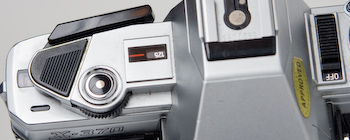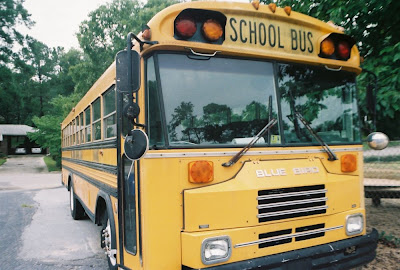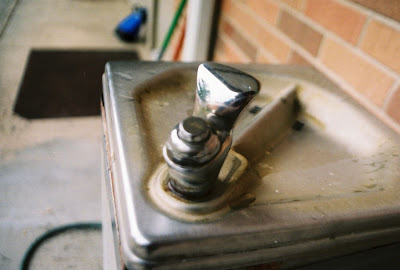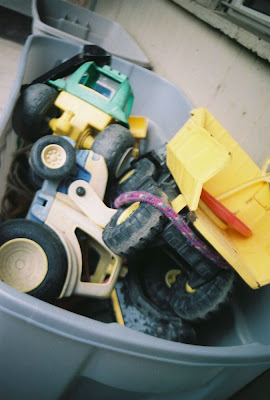|
|
The $50 Film Camera Project
Minolta X-370
The Back Story:
Way back in 2005, when dSLRs were prohibitively expensive for people finishing their Philosophy degrees, I decided I wanted a digital camera. I looked at lots and lots of point-and-shoots, compared specs and prices and finally settled on a nice Canon model with some manual exposure control and a decent zoom lens.
I returned it to the store the next day.
I decided a point-and-shoot wasn't going to cut it for me, so I took my search to eBay. There I found this lovely piece of machinery:
  Three lenses, a camera bag, and a motorized winder, and I got it all for $35!
Three lenses, a camera bag, and a motorized winder, and I got it all for $35!
As it happened, I came into a hand-me-down Canon just a few months after getting the Minolta and it got set aside after only about three rolls. Three years, a digital p&s and a new dSLR later, I rediscovered the Minolta thanks to the $50 Film Camera Project over at the Epic Edits blog.
When I found out about the contest there were only a few days left, so I dusted off (literally) the X-370, popped in some expired 800 speed color film I had lying around and took it to school with me.
The Camera:
|
The first difference I noticed between this camera and my usual dSLR was the weight. This camera has some heft to it. At the same time, it's a little bit blocky, lacking the hand-conforming curves of a newer model. That said, it's easy to hold on to and my fingers easily found the shutter release, film advance lever, and shutter speed selector dial. |

|
 |
Operating the camera is actually much more intuitive, I found, than my dSLR. Aperture is controlled via the aperture ring on the lens which I operated with my left hand, while shutter speed is adjusted with the right index or middle finger via a dial in front of the film advance lever. The dial is highly textured and each stop clicks solidly into place very satisfactorily. Most of the time, however, I left the shutter on AUTO, allowing the camera's aperture-priority exposure system to select my shutter speed for me. All in all, I'm fairly happy with the results.

|
|
The display through the eyepiece lists the available shutter speeds with a blinking red rectangle next to the suggested shutter speed for the given aperture. The shutter speed currently selected displays as a solid red rectangle. This makes selecting the right exposure as easy as lining up two lights. Once again, I found the controls incredibly intuitive. |

|

|
The only thing on the X-370 powered by the battery is the light meter, so if your battery does go dead, you can keep shooting using the "sunny 16" rule. This also means that the shutter is (I assume) powered by a spring of some sort that is wound or cocked when the film is advanced manually. The shutter/mirror retraction is loud. This is not the camera you'd want to use during a wedding ceremony. The other drawback simply has to do with my own forgetfulness. I missed a couple of cool shots because I had forgotten to advance the film after my last picture, so the next time I pressed the shutter release nothing happened. Had I bothered to attach the auto-winder, though, that wouldn't have been a problem. |
|
My first few photos were taken with the 28mm lens. The wide angle was refreshing after shooting for several months with a crop-sensor camera and only one zoom lens that gave me a maximum equivalent focal length of about 50mm. The focal ring on this lens was very tight and I love the softness the image gets as objects move out of focal range.
The colors of the toys in this plastic container were really vibrant, and I cant say I'm thrilled with their reproduction here. Of course, that could be bad metering on the camera's part, it could be a not-too-great lens, or it could be cheap one-hour processing and scanning.
|

|
 |
At this point I switched from the 28mm lens to the 135mm. I'm a lot more comfortable in this range, as I tend to shoot more portraits than anything else. This little girl was very sweet to let me take her picture for what must have been the tenth time this week. She's a good sport.
|
|
The front end of the 135mm lens had gotten banged up pretty badly at some point before I bought it, so it wasn't possible to put any filters on it. It's not that big a deal to me as the only filters I own are protective UV, but I wouldn't mind having that extra layer of protection between my favorite of the three lenses and the cold, hard world. |

|

Like the 28mm, the focus ring on the 135mm is satisfyingly tight. It actually makes for a bit of a workout when dramatically changing focal distances, but I found that actually controlling my focal length was a welcome respite from the *whirr whirr* *whirr whirr* searching of automatic focus. It feels good to be in control.


   
After a hard day of photography (and a some teaching, as well) I went home and took a well-deserved nap. I figured when my wife got home I'd use her as my model to finish out the roll.
|

She doesn't look terribly happy about it, does she?
|

|
Ah, got the exposure a little better on the second one.
I feel I should also point out that after each of these shots I took the camera from my eye and stared at the back of it, momentarily confused by why it wouldn't show me the photo I'd just taken.
|
 |
When I shot film exclusively, I never used flash, mainly because I had absolutely no idea how to take decent pictures using it. Since I got a dSLR, though, I've been experimenting and reading a lot of Strobist, so I figured I'd give a little off-camera lighting a shot.
 I also decided to switch to the third lens that came with the camera, a 35-75mm zoom. I also decided to switch to the third lens that came with the camera, a 35-75mm zoom.
|
 |
The zoom lens had a much looser barrel than either of the other lenses I'd used. It left me with the disconcerting feeling that my shot was going to go out of focus at any moment if I didn't breathe just right. |

|
I had hooked up a cheap radio trigger to my Vivitar 285HV and shot it through a white umbrella for these photos. Despite the fact that the shutter speed was only 1/60 of a second, you can see the black banding of an out-of-sync flash coming into most of the pictures. Obviously, I also overexposed them. I'm going to blame that on not having a flash meter, though, not the camera.
|
|
It was getting late so I fired off a few more shots with the flash. It was still strange not chimping the back, but stranger to know that I was really very limited by the amount of unexposed film left on the roll. It gave me more caution about pressing the shutter release, but also a greater sense of urgency. Each frame actually matters on film. |

|
 |
My wife is quite patient...
|
 ...and quite sultry...
...and quite sultry...
|
|
...and frequently silly.
|

|

|
After all the shots I took of her, it only seemed fair that I jump in for one as well.
The self-timer works as advertised.
|
With the X-370 already mounted on the tripod, I looked out the window and saw the sun setting behind our apartment complex. I pulled off the zoom, put the 35mm back on the body, set the exposure to aperture priority, went out on the back porch and, using the self-timer again, took what was easily my favorite photo of the roll.
 All in all, I'm delighted with the Minolta X-370. Everything about the way it operates is intuitive, it makes shooting at different apertures and shutter speeds a breeze, and with the auto-winder, the problem of advancing the film between every shot is no problem at all. I think I'll probably leave the 135mm lens on it most of the time, keeping around the 35mm for shots like the last one in this set. Next time I use the X-370, I'll buy some fresh film and have it developed by people who know a bit more about photography than my local discount store. All in all, I'm delighted with the Minolta X-370. Everything about the way it operates is intuitive, it makes shooting at different apertures and shutter speeds a breeze, and with the auto-winder, the problem of advancing the film between every shot is no problem at all. I think I'll probably leave the 135mm lens on it most of the time, keeping around the 35mm for shots like the last one in this set. Next time I use the X-370, I'll buy some fresh film and have it developed by people who know a bit more about photography than my local discount store.
Thanks to anyone who has taken the time to read my extensive commentary and look at these photos. Thanks to Brian Auer over at the Epic Edits blog for the inspiration and to my lovely wife, who is far more beautiful than any photograph I've ever taken of her.
|
|

 Three lenses, a camera bag, and a motorized winder, and I got it all for $35!
Three lenses, a camera bag, and a motorized winder, and I got it all for $35!
 I also decided to switch to the third lens that came with the camera, a 35-75mm zoom.
I also decided to switch to the third lens that came with the camera, a 35-75mm zoom.

 ...and quite sultry...
...and quite sultry...


 All in all, I'm delighted with the Minolta X-370. Everything about the way it operates is intuitive, it makes shooting at different apertures and shutter speeds a breeze, and with the auto-winder, the problem of advancing the film between every shot is no problem at all. I think I'll probably leave the 135mm lens on it most of the time, keeping around the 35mm for shots like the last one in this set. Next time I use the X-370, I'll buy some fresh film and have it developed by people who know a bit more about photography than my local discount store.
All in all, I'm delighted with the Minolta X-370. Everything about the way it operates is intuitive, it makes shooting at different apertures and shutter speeds a breeze, and with the auto-winder, the problem of advancing the film between every shot is no problem at all. I think I'll probably leave the 135mm lens on it most of the time, keeping around the 35mm for shots like the last one in this set. Next time I use the X-370, I'll buy some fresh film and have it developed by people who know a bit more about photography than my local discount store.




















